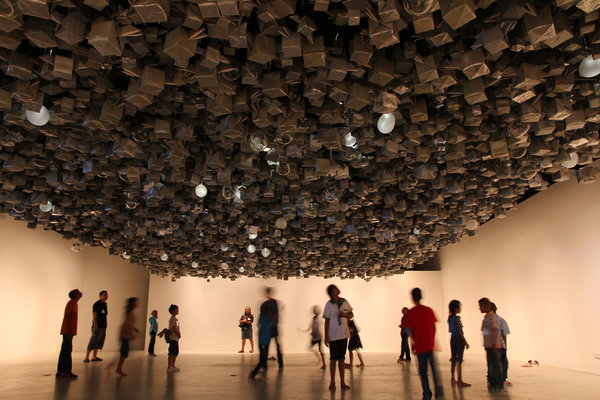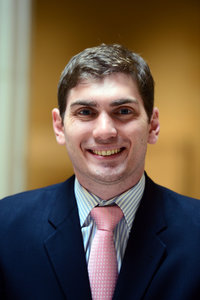Toledo Museum of Art (TMA) Assistant Director Adam Levine believes in boosting fluency in “visual literacy.”

Pinaree Sanpitak’s “Anything Can Break,” pictured on display in Bangkok in 2011. Photo Courtesy Toledo Museum of Art
“We’re pivoting back to a world that communicates predominantly through images,” Levine said. “This obsession with the written word, with textural literacy, is only a few hundred years old. There’s been this 500-year window from Gutenberg’s invention and the advent of the Internet where the word dominated. Now more than ever it’s really important to be able to extract meaning from the visual world.”
From Nov. 5-8, TMA will host the International Visual Literacy Association’s 47th annual conference, “The Art of Seeing: From Ordinary to Extraordinary.” Organizers are expecting around 300 people per day with attendees hailing from at least four continents.
While most of the conference is for paid attendees only, TMA is presenting eight keynote speakers to the public free of charge.
The speakers — innovators from fields as varied as medicine, film and education — will each address the rise of visual language.
“We’re trying to sketch this world of possibilities for how visual literacy can be applied,” Levine said. “We think we’re going to generate some real momentum around this.”
The eight speakers are:
- 9 a.m. Nov. 6: Anthropologist David Howes is a professor of anthropology and the director of the Concordia Centre for Sensory Studies at Concordia University in Montreal. His research focuses on how senses are formed by culture and what the world is like to societies that emphasize touch or hearing rather than sight. Howes has conducted field research on the cultural life of the senses in Papua New Guinea, Northwestern Argentina and the Southwestern United States.
- 3 p.m. Nov. 6: International ceramic artist Magdalene Odundo is known for her distinct hand-built anthropomorphic vessel forms. Odundo is an expert in the history of pottery and its meaning to societies through the ages, her own work being inspired by the creations of Nigerian and Kenyan potters of the past.
- 9 a.m. Nov. 7: Through his specialty in polytrauma (multiple devastating injuries), plastic surgeon Joseph Rosen, a Dartmouth Medical School professor, examines the role of the face as an essential part of the human identity. His reconstructive work on patients who have suffered devastating injuries from bullets, bombs, infection and disease has led him to his role as a U.S. Department of Defense department consultant on a team evaluating uses for regenerative medicine and transplantation for wounded soldiers. His interests include biomedical engineering, international medical relief work and virtual reality stimulators in education.
- 2:15 p.m. Nov. 7: Philip Yenawine has been engaged in museum education for 30 years, 10 of them spent as director of education at the Museum of Modern Art (MoMA) in New York City. He is co-founding director of Visual Understanding in Education, a nonprofit educational research organization that develops and studies programs using art to teach thinking and communication skills.
- 3:40 p.m. Nov. 7: Comic book artist and educator Nick Sousanis wrote and drew the dissertation for his 2014 doctorate in education at Teachers College, Columbia University, entirely in comic book form. Titled “Unflattening,” the work’s form embodies its argument for the importance of visual thinking in teaching and learning. A book version will be published by Harvard University Press in March. Before coming to New York City, he was immersed in Detroit’s arts community, where he co-founded the arts and cultural site thedetroiter.com and became the biographer of legendary Detroit artist Charles McGee.
- 9 a.m. Nov. 8: Documentary filmmaker Stephen Apkon founded the Jacob Burns Film Center in Pleasantville, N.Y., with a vision of establishing a hub for independent, foreign and documentary films and education. The center has grown to become a major cultural destination and a national leader in the field of visual literacy, including programming for underserved children. More recently, Apkon founded Chakana Media, a documentary production company developing films focused on critical societal issues.
- 11:50 a.m. Nov. 8: Educator Lynell Burmark is a passionate advocate of using visuals to better educate students of all ages. Burmark’s extensive teaching experience spans kindergarten through graduate school, while her visually enhanced presentations inspire educators across the globe.
- 3 p.m. Nov. 8: Ohio artist Aminah Robinson combines traditional art materials with found objects such as buttons, cloth, leather, twigs, shells and music box workings to create 2-D and 3-D works of art, including books and rag paintings. Many of them are about her family, community and the stories she has been told by her elders. She also researches and depicts the lives of abolitionists, civil rights leaders, musicians and writers. Robinson’s art is grounded in her belief in the African concept of Sankofa, which means learning from the past in order to move forward.
“This is a group of people who, though they come from very disparate fields, share a forward-thinking approach to their work,” said TMA Director Brian Kennedy in a news release. “They have used visual language to advance disciplines from medicine to education. What they have to say is crucial as we navigate a world where people have begun to communicate with pictures as frequently as with words.”
TMA is also offering two free exhibitions affiliated with the conference. “Speaking Visual: Learning the Language of Art” opened Oct. 31 and features works culled from the TMA collection. “InSight: Contemporary Sensory Works” opens Nov. 5 and will feature work by Robinson, Odundo and Pinaree Sanpitak.
For more information, visit toledomuseum.org or www.vislit.org.























